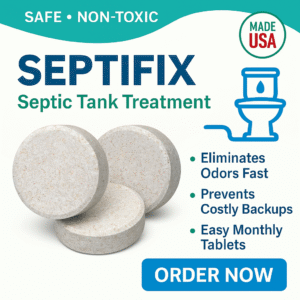Thinking about installing your own septic system on your Ontario property—without hiring a licensed installer or engineer? You’re not alone. Many rural landowners and DIY enthusiasts want to save money by doing the work themselves. But before you start digging, it’s important to understand Ontario’s rules, permit requirements, and what’s really at stake if you try to bypass the law.
Quick Picks: Top Tools & Materials for Septic DIY Projects (If Permitted)
-
Best Overall:
NDS 4-in. Septic Leach Line Pipe (10 ft) -
Best Budget:
QWORK Soil Test Probe Kit -
Best Premium:
OATEY Septic Tank Outlet Filter
Buyer’s Guide: Ontario Septic System Installation Laws & What’s Required
- Permit Is Mandatory—No Exceptions: In Ontario, you must obtain a permit from your local building department before installing or replacing any septic system. This applies to both new and replacement systems, no matter who is doing the work.
- Design Approval Is Required: The proposed system must be designed according to the Ontario Building Code and approved by the building authority. You’ll need a site plan, soil analysis, and detailed drawings—even for DIY projects.
- DIY Is Allowed (With Strict Conditions): Unlike some US states, Ontario often allows homeowners to install their own septic system, as long as they follow all code requirements, use approved materials, and pass mandatory inspections.
- Inspections at Multiple Stages: Local inspectors must check the excavation, tank placement, leaching bed, and final cover before any use. Missing an inspection can mean ripping up the system and starting over.
- Licensed Installer Recommended: While you can do your own install, many choose a licensed installer to avoid costly mistakes, ensure compliance, and protect resale value.
- Heavy Penalties for Skipping Permits: Installing a septic system without a permit is illegal in Ontario. You risk fines, a stop work order, removal of the system, and even issues when selling or insuring your home.
Bottom line: You cannot install a septic system in Ontario “without” a permit, soil analysis, and passing inspections—even for your own home or cottage.
Full Reviews: Best DIY Septic Tools & Materials (If Allowed)
NDS 4-in. Septic Leach Line Pipe (10 ft)
Who it’s for: Homeowners or DIYers approved to run leaching bed lines on a new or replacement system.
- Key Benefits:
- Heavy-duty, approved for residential septic
- Perforated for proper drainage
- Easy to handle, cut, and install
- Pros:
- Widely used across Canada
- Affordable and reliable
- Compatible with gravel or chamber beds
- Cons:
- Does not replace full system design
- Gravel, filter cloth, and fittings sold separately
Final Verdict: Great for permitted, code-compliant DIY installations.
Order NDS Pipe.
QWORK Soil Test Probe Kit
Who it’s for: Homeowners preparing for site evaluation or learning about their soil before the pros arrive.
- Key Benefits:
- Pulls clean soil samples for quick analysis
- Reusable and easy for any homeowner
- Helps prep for official inspection
- Pros:
- Affordable and practical
- Can be reused for gardening or landscaping
- Helpful before hiring a soil scientist
- Cons:
- Not a replacement for required soil tests
- Manual sampling effort
Final Verdict: Good for site prep, but not a substitute for official reports.
Shop Soil Probe.
OATEY Septic Tank Outlet Filter
Who it’s for: Anyone upgrading an existing tank or ensuring a new install meets Ontario’s code.
- Key Benefits:
- Prevents solids from leaving the tank and damaging the bed
- Easy to install and maintain
- Approved in many code jurisdictions
- Pros:
- Boosts system longevity
- Fits most tanks
- Affordable way to meet inspection standards
- Cons:
- Annual inspection/cleaning required
- Not a complete system—just the filter
Final Verdict: Important for code-compliance and drainfield health.
Order OATEY Filter.
Comparison Table: Septic DIY Tools & Materials (Ontario)
| Name | Key Features | Specs/Capacity | Price Link |
|---|---|---|---|
| NDS Leach Line Pipe | 4-in., perforated, approved | 10 ft, HDPE | View Price |
| QWORK Soil Test Probe Kit | Stainless steel, reusable | 12 in. probe | View Price |
| OATEY Tank Outlet Filter | Protects leach bed, easy clean | Universal fit, removable | View Price |
Frequently Asked Questions (FAQ)
Can I install my own septic system in Ontario?
Yes—if you get a permit, use approved plans and materials, and pass all inspections. No one can install a septic system “without” legal approval and oversight.
What are the risks of DIY septic installation?
Mistakes can lead to health hazards, water contamination, system failure, and fines. Always follow the Building Code and get your work inspected.
Can I save money by installing my own system?
Possibly, but you’re still responsible for permits, soil tests, and inspections. Professional installation often protects you from costly errors and boosts property value.
How long does it take to get a septic permit in Ontario?
It varies—usually 2–6 weeks after submitting a complete application and plans. Plan ahead and don’t skip steps.
What happens if I install without a permit?
You risk large fines, stop work orders, removal of the system, and major trouble with future property sales or home insurance.
Conclusion & Call to Action
While Ontario allows homeowner installs in some cases, you cannot legally install a septic system “without” a permit, code-compliant design, or inspection. Don’t risk your health, your wallet, or your home—always follow the rules and get professional help if you’re unsure.
Planning a septic project? Start with your local building department, get a permit, and use the right tools for safe, legal installation!
